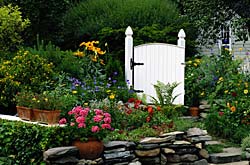Nontraditional Gardens: Winter and Rock Gardens
See if We Have Top-Rated
Landscape Contractors in Your Area

Many homeowners love gardening but find themselves limited because of seasonal and climate conditions. However, non-traditional gardens like rock gardens and winter gardens are becoming increasingly popular with gardening fans across the country. By following certain specialized techniques, garden lovers can enjoy their hobby (as well as fresh fruits and vegetables) year round. If you think indoor winter gardening is too expensive, outdoor winter gardening is too difficult, or rock garden design is too limiting, think again! Here are a few corner stones of non-traditional gardening, and a few tips to get you started:
Modern Rock Garden Design
Don't let the name fool you: rock garden design is about more than just rocks! While the simplicity of rock garden designs are one of the things that draws many to this unique discipline, the inclusion of plants and even a water feature or two can take the practice of rock gardening to the next level.
Rock garden designs are typically focused on creating an attractive landscape in a place without much water. While the stark, Zen nature of traditional rock gardens is pleasing to some, most people find that the color, texture, and diversity of modern rock garden design is a bit more to their liking. Since the places where rock gardens are popular are typically not ideal areas for supporting grass or imported plants, modern rock garden design is focused on using the flora that occurs naturally to spice things up. Almost every region has a few beautiful local plants that thrive in that area's climate conditions. By incorporating such plants into your rock garden design, you can add accents of color and texture to an arid landscape without having to worry about fertilizer or frequent watering.
Indoor Winter Gardening
Indoor winter gardening is mainly focused on the year round growing of vegetables and flowers you'd generally only see in the spring and summer. Since there is certain equipment needed to provide warmth and light, indoor winter gardening is a bit of an investment the first year. However, with careful planning, indoor winter gardening can be done for a lot less than you might imagine. By planning your garden space to make optimal use of winter time sunlight, you can significantly reduce the initial investment needed for lighting and heat; by choosing specific varieties of plants known for thriving in indoor conditions, you can significantly increase your chances of success.
Give your home the gift of curb appeal! Use this link to
Install LandscapingAs the success of indoor winter gardening is highly dependant on several key factors, it is generally best to have a professional to consult with, at least during the planning stages. Any friends and family members familiar with indoor winter gardening techniques are often happy to share their knowledge with others, but when it comes to calculating sunlight hours and solar gain, ordering special materials, or even calling for minor alterations to your home, having a pro on board is never a bad idea.
Outdoor Winter Gardening
Outdoor winter gardening is a unique discipline. With the help of a professional in the know, homeowners in more areas of the country than you might think can look forward to growing plants all year long. While few flowers or vegetables will survive below freezing temperatures, certain species of shrubs and small evergreens as well as some root crops are extraordinarily hardy. Obviously, those who live in climates where the temperature only goes below freezing a few days a year will have more leeway when it comes to outdoor winter gardening; however, with good plant selection, some well-thought-out planning, and a little taste for adventure, you'll be surprised at what your garden can look like in December, even if you live in a colder climate.

